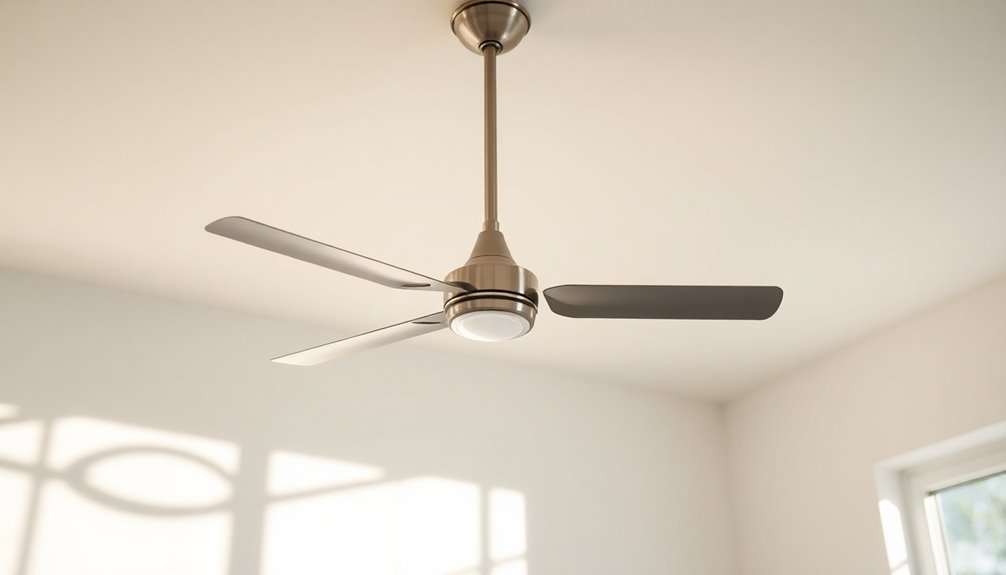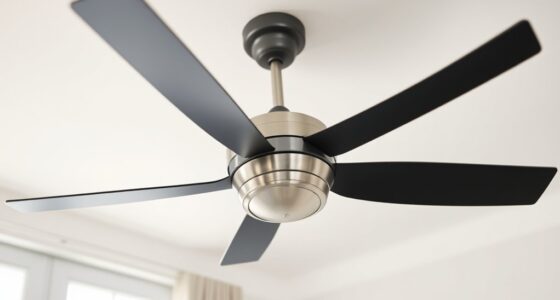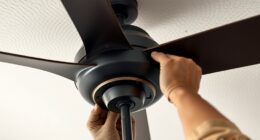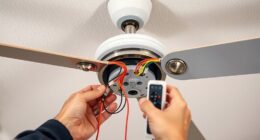Ceiling fans usually last around 7 to 10 years, but high-quality models can last over 15 years if well-maintained. Durability can be affected by frequent use and environmental factors like humidity and temperature. If your fan is wobbling, making strange noises, or showing signs of corrosion, it might be time for a replacement. Regular maintenance, such as cleaning and lubricating moving parts, can greatly extend your fan's lifespan. If you're curious about choosing the right fan or the benefits of modern features, there's plenty more to discover!
Key Takeaways
- Ceiling fans typically last between 7 to 10 years, with high-quality models potentially exceeding 15 years.
- Frequent high-speed operation can reduce a fan's lifespan to under 10 years due to increased wear and tear.
- Durable materials, like metal blades, enhance durability and resistance to damage compared to plastic alternatives.
- Environmental factors, such as humidity and temperature, significantly influence a fan's longevity and performance.
- Regular maintenance, including cleaning and lubrication, can extend the lifespan and efficiency of ceiling fans.
Average Ceiling Fan Lifespan

When you invest in a ceiling fan, it's important to know that the average lifespan typically ranges from 7 to 10 years.
However, if you choose a high-quality model, you might enjoy it for up to 15 years or even longer. This longevity largely depends on how you use and maintain your fan.
If you frequently run your ceiling fan, it may wear out faster than one that's used sparingly. The materials used in construction also play a significant role in determining the average ceiling fan lifespan. Fans made from durable materials tend to last longer.
Additionally, environmental factors, like humidity and temperature, can impact your fan's durability. Proper installation is essential; a well-installed fan operates more efficiently and lasts longer.
Regular maintenance practices, such as cleaning and lubrication, can greatly extend its lifespan.
Don't forget to perform routine inspections for any signs of wear and tear. By addressing issues early, you can potentially prolong your ceiling fan's operational lifespan.
Understanding these elements will help you make informed decisions about your ceiling fan investment.
Factors Affecting Longevity

When it comes to ceiling fans, the quality of materials you choose plays a big role in how long they last.
How often you use your fan and the maintenance practices you follow can also greatly impact its longevity.
Understanding these factors can help you make informed choices for lasting performance.
Quality of Materials
The longevity of ceiling fans heavily depends on the quality of materials used in their construction, impacting everything from motor performance to blade durability.
If you want your ceiling fan to last, you should consider the following factors:
- High-quality motors can last up to 20 years, while cheaper ones might fail in just 7 to 10 years.
- Blade materials matter—metal blades generally resist damage better than plastic, ensuring durability.
- Proper installation is vital; a well-installed fan operates more efficiently and is less prone to mechanical issues.
Environmental factors, like humidity and temperature, can also affect the quality of materials.
For example, fans exposed to humid conditions may wear out faster if they aren't designed for that environment.
Regular maintenance, such as lubricating the motor and tightening screws, can help mitigate wear on lower-quality materials, extending your fan's life.
Investing in quality materials is essential for ensuring your ceiling fan stands the test of time, providing comfort and style in your space for years to come.
Choose wisely, and you'll enjoy the benefits for longer!
Frequency of Use
Quality materials certainly set the foundation for a ceiling fan's longevity, but how often you use it can dramatically influence its lifespan as well. The frequency of use plays a significant role; if you're running your fan daily on high settings, you might find its lifespan dwindling to under 10 years. Continuous operation means your fan's motor and components face more wear and tear, which can lead to quicker degradation.
If you place your ceiling fan in a high-traffic area or frequently use it to cool large spaces, expect that increased demand to take a toll on its durability.
On the flip side, if you use your ceiling fan sparingly or only during specific seasons, it could last longer—sometimes even exceeding the average lifespan of 10 to 15 years.
Ultimately, being mindful of the frequency of use can help you make informed decisions about when to run your ceiling fan and when to give it a break. By moderating your use, you can enhance its longevity and enjoy the comfort it provides for years to come.
Maintenance Practices
Proper maintenance practices can make a significant difference in how long your ceiling fan lasts. By keeping up with regular maintenance, you not only enhance performance but also prolong its life.
Here are a few important practices to take into account:
- Clean the blades and housing regularly to prevent dust buildup, which can strain the motor.
- Lubricate moving parts periodically for smooth operation, reducing wear and tear.
- Inspect electrical wiring for frays or damage to guarantee safe operation and prevent electrical issues.
Additionally, make sure all screws and bolts are tightened. Wobbling fans can lead to instability and further mechanical problems over time.
Following the manufacturer's maintenance guidelines is vital, as these recommendations optimize performance based on your specific model.
Signs of Wear and Tear

Attention to the signs of wear and tear in your ceiling fan can save you from costly repairs or even replacements. One of the first things to look for is unusual noises, like buzzing or grinding, which often indicate mechanical issues that need addressing.
If you notice your fan blades wobbling, that could signal loose parts or an imbalance, potentially leading to more serious damage if not fixed quickly.
Another red flag is reduced airflow, suggesting motor problems or internal mechanical issues that could be a sign of wear and tear.
If your lights flicker or show inconsistent brightness, that may point to electrical issues related to aging components in the fan.
Don't ignore visible signs of rust or corrosion on metal parts, as this deterioration can lead to eventual failure.
Maintenance Best Practices

To keep your ceiling fan running smoothly, establish a regular cleaning schedule to prevent dust buildup.
Don't forget to lubricate moving parts periodically and inspect the wiring for any signs of wear.
Regular Cleaning Schedule
Keeping your ceiling fan clean is essential for its performance and longevity. Regular cleaning is recommended every month to prevent dust accumulation, which can lead to wobbling and decreased airflow.
To maintain its efficiency, consider these simple tips:
- Breathe easier: A clean fan promotes better air quality in your home.
- Prevent overheating: Regular cleaning helps avoid mechanical issues that can arise from dust buildup.
- Extend lifespan: A well-maintained fan can serve you for years without major problems.
Using an extendable duster is a smart way to reach those high blades without risking damage.
Make certain to clean both the blades and motor housing to maximize airflow and efficiency. Always follow the manufacturer's guidelines when it comes to cleaning products, as harsh chemicals might harm the finish or components.
Additionally, periodically inspecting your fan for dust and debris buildup can help you catch potential issues early, allowing for timely maintenance.
Lubrication of Moving Parts
Regular cleaning is just one part of maintaining your ceiling fan; lubricating its moving parts is equally important for peak performance.
Regular lubrication minimizes friction between components, enhancing both performance and longevity. To get the best results, use a lightweight machine oil or a fan-specific lubricant. Steer clear of grease, as it can attract dust and debris, causing more harm than good.
Aim to lubricate the motor bearings and other moving parts at least once a year. This proactive approach can prevent wear and keep your fan running smoothly.
If your fan starts making unusual noises, applying lubrication might resolve the issue. However, if the sounds persist after lubrication, you should inspect the fan further.
Always follow the manufacturer's guidelines for lubrication, as this can help prevent damage and guarantee that your fan operates efficiently throughout its lifespan.
Remember, proper lubrication not only keeps your fan functioning well but also extends its life, allowing you to enjoy the comfort it provides for years to come.
Regularly checking and maintaining the lubrication will keep your fan in top shape, making sure you get the most out of your investment.
Inspect Wiring Regularly
Over time, the wiring in your ceiling fan can become vulnerable to wear and tear, making routine inspections essential for safety and performance.
To guarantee your fan operates efficiently, you should inspect wiring regularly for any issues. Keep an eye out for:
- Visible frays or damage that could become a fire hazard.
- Loose connections that may lead to electrical shorts or failures.
- Signs of overheating, like discoloration or melting, indicating serious electrical problems. Additionally, improved air quality can contribute to a safer indoor environment by reducing potential hazards.
By addressing these potential risks, you not only enhance the lifespan of your ceiling fan but also protect your home. Additionally, regular maintenance can significantly improve energy efficiency and reduce overall electricity costs.
Make certain all electrical connections are secure and follow manufacturer guidelines for proper maintenance.
Scheduling a professional inspection every few years can be a smart move, providing you with peace of mind that your electrical system is in top shape.
Energy Efficiency Considerations

When considering ceiling fans, energy efficiency plays an essential role in both your comfort and your utility bills. Older ceiling fans often lack energy-saving features, resulting in higher energy consumption. By upgrading to energy-efficient models, particularly those that are ENERGY STARⓇ-rated, you can greatly reduce your heating and cooling costs.
These newer fans utilize advanced technology and design, enhancing their performance while lowering your energy bills. Additionally, many modern ceiling fans come with integrated LED or CFL lighting, which further decreases energy usage for illumination. This means you not only save on cooling costs but also on lighting expenses.
Investing in energy-efficient ceiling fans not only enhances your comfort but also supports a more sustainable home by minimizing overall energy usage. Moreover, these newer models generally have longer lifespans due to improved materials and construction, reducing the need for frequent replacements. Furthermore, energy-efficient appliances, including ceiling fans, contribute to a more sustainable home by lowering overall energy consumption, similar to advancements seen in heat pump technology.
Consequently, by choosing energy-efficient ceiling fans, you not only create a comfortable living environment but also make a smart financial decision. Embracing these options can lead to substantial savings over time, making your home both eco-friendly and cost-effective.
Common Mechanical Issues

Even with energy-efficient ceiling fans, mechanical issues can still arise, impacting their performance and lifespan. You might notice a few common mechanical issues that can lead to frustration and discomfort in your home.
- Wobbling blades, often caused by loose screws or dust accumulation, can create an annoying distraction.
- Unusual noises like buzzing or grinding may signal motor wear, especially in older fans, leading to concerns about reliability.
- Flickering lights could indicate electrical problems, often linked to faulty wiring, which can be both alarming and inconvenient.
Additionally, reduced airflow and sluggish operation might suggest motor problems that require urgent attention.
Regular maintenance is key to preventing these issues; lubricating parts and tightening screws can save you from costly repairs down the line.
By staying proactive, you can guarantee your ceiling fan continues to function properly and efficiently.
Don't ignore these common mechanical issues—addressing them promptly will help extend the lifespan of your ceiling fan and keep your space comfortable.
Signs of Replacement Needed

While regular maintenance can prolong the life of your ceiling fan, certain signs indicate it might be time for a replacement. If you notice wobbling blades, it could signal installation issues or an imbalance. If you can't fix it, you may need to replace your ceiling fan.
Unusual noises like buzzing or squeaking, especially after maintenance attempts, often point to deeper mechanical problems that justify a new fan.
Another red flag is when your fan fails to respond to controls or has considerably diminished speeds across settings—this typically signals motor failure. If you find yourself dealing with recurring issues, even after repairs, investing in a new fan can be more economical in the long run.
Finally, keep an eye out for visible signs of wear, such as cracks or rust on components. These can compromise safety and efficiency, prompting an urgent need to replace your ceiling fan.
Recognizing these signs early can help you avoid further complications and guarantee a comfortable environment.
Aesthetic Upgrades and Trends

When it comes to ceiling fans, modern design trends offer you a chance to elevate your space with style.
You can choose from sleek contemporary looks or rustic finishes that fit your decor perfectly.
Plus, with customization options like interchangeable blades and light fixtures, you can truly make your fan your own. Additionally, many fans now feature energy-efficient models that not only save on electricity costs but also come in stylish designs.
Modern Design Trends
In today's homes, ceiling fans are no longer just functional; they're also stylish design elements that enhance your space. Modern ceiling fan designs showcase sleek lines and minimalist aesthetics, perfectly aligning with contemporary decor. You can easily find fans with customizable finishes like brushed nickel, matte black, and oil-rubbed bronze, allowing you to match your decor seamlessly.
Here are some ways modern ceiling fans elevate your home:
- Integrated LED lighting provides energy-efficient illumination that adds both functionality and flair.
- Smart ceiling fans with Wi-Fi connectivity let you control settings through mobile apps or voice commands, keeping up with the latest tech trends.
- Bold, statement-making fans serve as focal points in spacious living areas, combining aesthetics with effective airflow.
Choosing the right ceiling fan not only improves air circulation but also transforms the ambiance of your room.
With so many stylish options available, you can easily find a fan that complements your personal style while enhancing your home's overall look. Embrace these modern design trends to create a space that feels both inviting and chic.
Customization Options Available
Exploring customization options for ceiling fans can dramatically enhance the aesthetic appeal of your home. With a wide variety of styles available—from modern and traditional to industrial—you can easily find a fan that complements your interior decor.
Customization options often include finishes like brushed nickel, oil-rubbed bronze, and matte black, giving you the versatility to match your fan with existing furnishings.
One of the most exciting customization features is the ability to swap out blades without replacing the entire unit. This lets you refresh the look of your ceiling fan while maintaining its functionality.
Additionally, many new fan designs come with integrated LED lighting, providing a cohesive look and energy-efficient illumination.
You'll also find customizable features like remote controls and smart home integration trending right now. These options not only enhance functionality but also align with modern design trends, making your ceiling fan as user-friendly as it's stylish.
Cost of New Ceiling Fans

Shopping for a new ceiling fan can be an eye-opening experience, with prices ranging from budget-friendly options to premium models.
You might find basic fans starting around $67.99, while more advanced options, like those with integrated LED lights, can reach up to $99.99 or more. On average, the cost of new ceiling fans typically falls between $70 to $150, though some premium models can exceed $200.
Consider these factors when shopping:
- Energy efficiency: Investing in a high-quality fan can lead to savings on your energy bill.
- Design and features: A stylish fan can enhance your room's aesthetic.
- Sales and discounts: Many retailers offer 15-20% off, making your purchase more affordable. Additionally, selecting an Energy Star certified fan can further enhance energy savings and comfort in your home.
Professional Installation Benefits

When you invest in a new ceiling fan, professional installation can make all the difference in maximizing its performance and longevity. By opting for expert help, you guarantee that the fan is mounted securely, reducing wobbling and potential safety hazards. Professionals know how to balance the blades, which minimizes noise and enhances airflow efficiency, ultimately saving you energy.
Here's a quick overview of the professional installation benefits:
| Benefit | Impact |
|---|---|
| Proper Mounting | Reduces wobbling and hazards |
| Blade Balancing | Minimizes noise, improves airflow |
| Code Compliance | Prevents future electrical issues |
Additionally, professionals are familiar with local electrical codes, guaranteeing safe and compliant installations. Hiring an expert also helps in validating your warranty, as improper installations can void manufacturer guarantees. They can recommend the best fan type and size for your space, optimizing both functionality and aesthetic appeal. In short, the professional installation benefits far outweigh the initial costs, leading to a safer, more efficient, and visually appealing ceiling fan experience.
Frequently Asked Questions
How Often Should You Replace a Ceiling Fan?
You should consider replacing your ceiling fan every 7 to 10 years, especially if you notice signs of wear like unusual noises or wobbling.
If it's frequently malfunctioning despite repairs, it might be more cost-effective to upgrade. Modern fans offer better energy efficiency and features that could enhance your comfort.
Keeping an eye on performance will help you decide when it's time to invest in a new ceiling fan for your space.
When Should Ceiling Fans Be Replaced?
You might notice your ceiling fan's performance taking a dip just as summer kicks in.
When you hear strange noises or feel uneven airflow, it's time to assess its condition.
If the fan wobbles or the speeds diminish, that's a clear sign it's time for a replacement.
Don't ignore persistent issues, especially after 7 to 10 years.
Upgrading to a modern, efficient model can enhance your comfort and save on energy bills.
How Do You Know if You Need a New Ceiling Fan?
You'll know you need a new ceiling fan if you hear unusual noises like buzzing or squeaking, or if the fan wobbles during operation.
Diminished airflow or a fan that runs slower than expected may signal motor failure.
Keep an eye out for frequent electrical issues, rust, or visible deterioration, as these can affect performance and safety.
If you notice any of these signs, it's definitely time to contemplate a replacement.
How to Know When a Ceiling Fan Is Bad?
Did you know that about 30% of ceiling fan issues stem from improper installation?
To know when your ceiling fan's bad, listen for unusual noises like buzzing or grinding, which often signal motor problems.
If you notice wobbling blades, flickering lights, or inconsistent airflow, it's time to investigate further.
Frequent shutdowns or ineffective cooling also indicate potential failure.
Trust your instincts—if it feels off, it might be time for a replacement.
Conclusion
In the grand dance of home comfort, your ceiling fan plays an essential role, but it won't last forever. By understanding its lifespan and keeping an eye on wear and tear, you can guarantee it continues to spin in harmony with your space. Regular maintenance and knowing when to replace it will keep your home breezy and stylish. So, don't let a tired fan waltz around your room—embrace the upgrade and enjoy the cool breeze freshening up your life!









